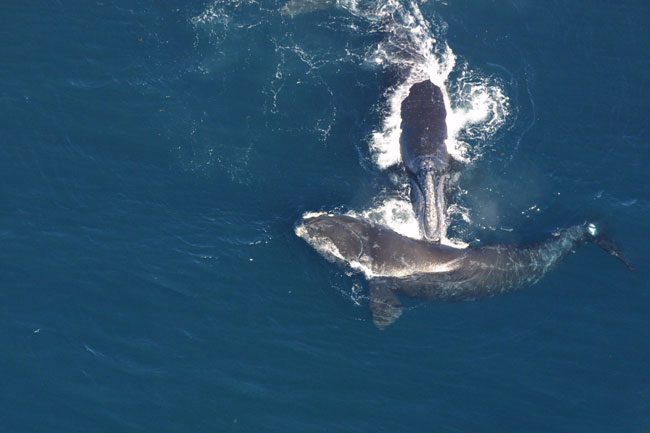At Least 3 Endangered Whales Found Off Tip of Greenland

A group of endangered North Atlantic right whales has been identified near Greenland in an area where the species was thought to be extinct, using a system of underwater microphones.
The discovery of at least three individual whales, presented this week at a meeting of the Acoustical Society of America in Portland, Ore., is particularly important, researchers say, because it is in an area that may be opened to shipping if the melting of polar ice continues, as expected.
Right whales were hunted for their blubber and baleen until a world-wide ban on right whale fishing was put into place in 1937. Scientists estimate there are fewer than 350 of these whales left in the oceans, according to the New England Aquarium. Right whale deaths are largely attributed to ship collisions in the busy waterways of the eastern United States. Over the last decade, ship collisions have been responsible for about 40 percent of all known North Atlantic right whale deaths.
To locate the new group of whales, a team of scientists from Oregon State University and the National Oceanic and Atmospheric Administration (NOAA) used a system of hydrophones that can record sounds from hundreds of miles away.
"The technology has enabled us to identify an important unstudied habitat for endangered right whales and raises the possibility that — contrary to general belief — a remnant of a central or eastern Atlantic stock of right whales still exists and might be viable," said OSU's David Mellinger, chief scientist of the project.
The scientists are unsure of exactly how many whales were in the region, which is off the southern tip of Greenland and the site of an important 19th-century whaling area called Cape Farewell Ground. But they recorded more than 2,000 right whale vocalizations in the region from July through December of 2007.
"We don't know how many right whales there were in the area," Mellinger said. "They aren't individually distinctive in their vocalizations. But we did hear right whales at three widely spaced sites on the same day, so the absolute minimum is three. Even that number is significant because the entire population is estimated to be only 300 to 400 whales."
Sign up for the Live Science daily newsletter now
Get the world’s most fascinating discoveries delivered straight to your inbox.
Only two right whales have been sighted in the last 50 years at Cape Farewell Ground, where they had been hunted to near extinction prior to the adoption of protective measures.
Right whales produce a variety of sounds, Mellinger said, and through careful analysis these sounds can be distinguished from other whales. The scientists used recordings of North Atlantic and North Pacific right whales to identify the species' distinct sounds.
The pattern of recorded calls suggests that the whales moved from the southwest portion of the region in a northeasterly direction in late July 2007, and then returned in September 2007 — putting them directly where proposed future shipping lanes would be likely.
"Newly available shipping lanes through the Northwest Passage would greatly shorten the trip between Europe and East Asia, but would likely cross the migratory route of any right whales that occupy the region," said Phillip Clapham, a right whale expert with NOAA's National Marine Mammal Laboratory. He participated in the study. "It's vital that we know about right whales in this area in order to effectively avoid ship strikes on what could be a quite fragile population."
This is the third time that Mellinger's team has used hydrophones to locate endangered right whales. Previously, they found right whales in the Gulf of Alaska, where only one confirmed sighting had taken place in 26 years, and off Nova Scotia.
The new study was funded by NOAA's Office of Ocean Exploration and Research.
- Video – Blue Whales Migrate North to Alaska
- Whale News, Images and Information
- Why Whales Sing










